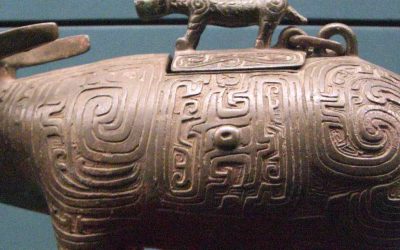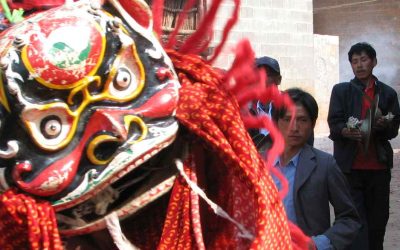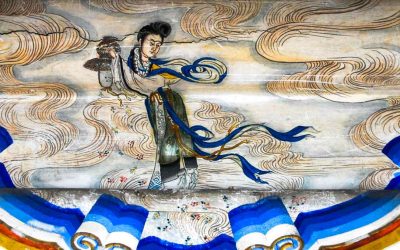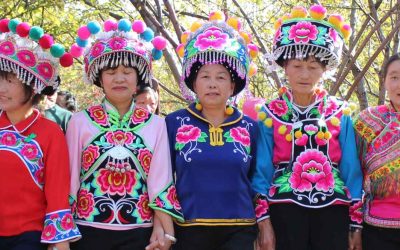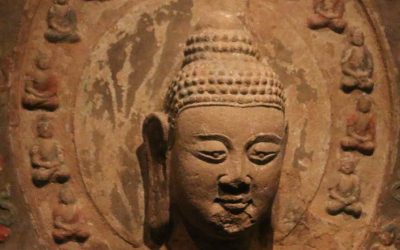A Giant Mandala in the Heart of Tibet
The Palkor of Gyantze is one of Tibet’s great marvels and a unique jewel of universal architecture and art. Its shape, scale, and iconography defy comparison with any other construction.
Amidst some of the highest mountains of central Tibet, on the ancient trade route linking Lhasa with India, lies the small town of Gyantze. There stands one of the most singular and dazzling monuments of the Buddhist world: the Palkor Chöde. With a silhouette that astonishes from the very first glance, the Palkor is neither palace nor fortress, neither monastery nor temple, but rather a kind of three-dimensional architectural mandala: a kumbum.
- An Architectural Form Without Parallel
While most Tibetan temples follow horizontal layouts inspired by Indian or Chinese models, the Palkor rises like a stepped pyramid of multiple levels, each containing rows of chapels. This structure follows a symbolic design, representing a universe through which the pilgrim ascends toward enlightenment. The term kumbum literally means “one hundred thousand images,” and in the case of the Palkor, the name is no exaggeration.
- An Artistic Treasure Without Equal
The interior of the kumbum contains 108 chapels distributed across six concentric levels. Each one is adorned with frescoes, statues, and mandalas that, on their own, could justify the existence of an entire religious center. In fact, anywhere else in the world, a single one of these chapels would be enough to attract pilgrims, scholars, and art lovers alike. The mural paintings that cover its walls—rendered in the Nepali-Tibetan style of the 15th century—still preserve a vividness of color and detail that has withstood centuries of weather, war, and neglect. Many of these images offer a compendium of cosmology, medicine, tantric ritual, and visions of the afterlife.
- History of Its Construction
The Palkor was built between the late 14th and mid-15th centuries under the patronage of the prince of Gyantze, Rabten Kunzang Phak, during a period of relative political stability and cultural openness in Tibet. It was a time when multiple Buddhist schools coexisted, and the monastery annexed to the kumbum was home to at least three traditions: Gelug, Sakya, and Kagyu. This coexistence explains the rich iconographic and doctrinal diversity found within, making the Palkor a living testament to a plural and dynamic Tibet.
- Symbolism in the Tibetan World
The Palkor is not merely a temple: it is an architectural mandala to be walked through, a physical visualization of the path to enlightenment. Ascending its levels is like progressing through the stages of tantra—from the outer circles of protection to the central deities who embody emptiness and compassion. Each chapel serves as a gateway to a specific teaching, and the whole structure forms a miniature cosmos. Its design, layout, and ritual function make it a monument of profound symbolic depth.
Visiting the Palkor Today
Despite the ravages of time and the iconoclastic campaigns of the 20th century, the Palkor still stands—lofty and magnificent, a reliquary of wisdom and beauty. Climbing its levels, pausing in its chapels, and attempting to uncover its mandalic meaning is a transformative experience. For those who observe it with care, the Palkor is not merely a monument—it is a silent teaching, a vertical pilgrimage to the heart of Tibetan Buddhism.
The mandalic structure of the Palkor recalls, in both function and symbolism, the great monument of Borobudur in Indonesia. Both can be read as three-dimensional mandalas, designed for the pilgrim to physically experience the transformations that masters achieve on the psychological plane.
About me: I have spent 30 years in China, much of the time traveling and studying this country’s culture. My most popular research focuses on Chinese characters (Chinese Characters: An Easy Learning Method Based on Their Etymology and Evolution), Matriarchy in China (there is a book with this title), and minority cultures (The Naxi of Southwest China). In my travels, I have specialized in Yunnan, Tibet, the Silk Road, and other lesser-known places. Feel free to write to me if you’re planning a trip to China. The agency I collaborate with offers excellent service at an unbeatable price. You’ll find my email below.
Last posts
The bull and the political development of Neolithic China
The bull and the political development of Neolithic China Since the history of the penetration of domestic cattle in China goes parallel to that of the political concentration that gave rise to the first cities and later to the first states, that slow penetration of...
THE LION-DANCE AS RELIGIOUS DANCE
THE LION-DANCE AS RELIGIOUS DANCE The lion-dancers first appeared in China under the Tang dynasty (a.d. 618-906), and made their debut at the court of the kings of Tibet about the same time. The lion-dancer represents a form of the Indian mime or burlesque juggler,...
Taosi. The first capital of China
Taosi. The first capital of China Taosi is one of the most important archaeological discoveries in China in the past decades. Located in the southern part of Shanxi province, is possibly the first urban center emerged in China. The excavation of the ancient city of...
Who is this Goddess of Heaven scattering flowers?
Who is this Goddess of Heaven scattering flowers? When we arrive in a country with a culture as different as China, it is as if a fog blanket covers our eyes, allowing us only a blurred vision of everything around us. Then we recognize the characters in their writing...
Why do you must visit a Chinese park?
Why do you must visit a Chinese park? Many experienced travelers to China include in their programs the visit a neighborhood market thinking that the essence of the culture of the people is concentrated there. And they have their point, but not only in the market you...
The most beautiful Buddhist sculpture in Beijing
The most beautiful Buddhist sculpture in Beijing It is the "Stone sculpture of the Sakyamuni Buddha with two guardians", which is in the Capital Museum of Beijing. It is dated in the Northern Wei Dynasty, in the 23rd year of the Emperor Taihe (499 AD) This statue is...





